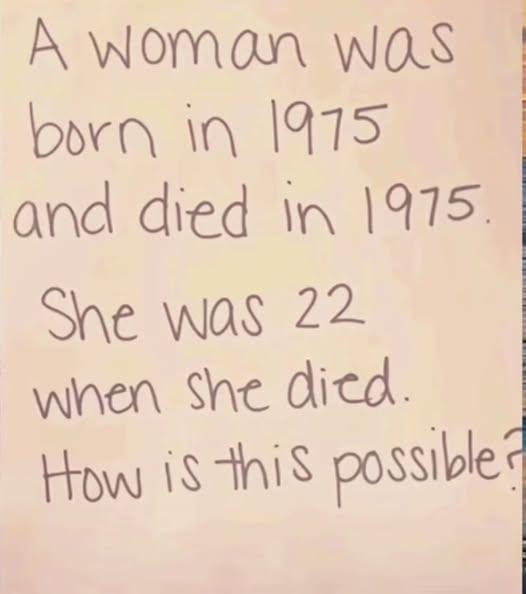Here’s a riddle that’s been confusing and amusing people all over the internet: “A woman was born in 1975 and died in 1975. She was 22 years old when she died. How is this possible?” At first glance, this statement seems to defy all logic. Most people read it and immediately assume it’s either a mistake or some kind of joke, because how could someone possibly be born and die in the same year and still be 22? That’s where the brilliance of the riddle lies—it challenges not your math skills but your perspective.

Most of us are conditioned to read numbers like “1975” as years, so our minds automatically go down the path of thinking in terms of dates and time. We picture a woman being born in the year 1975 and dying in that same year, which would obviously make it impossible for her to be 22 years old. So naturally, our brains either shut down or try to stretch logic to make the numbers fit—some even entertain far-fetched ideas like time travel or metaphors. But riddles like this aren’t about bending the rules of reality—they’re about changing how we interpret the clues. The trick here is that the number 1975 isn’t referring to a year at all. It’s a perfect example of how a simple shift in interpretation can make something seemingly impossible suddenly make perfect sense.
If you reframe the riddle and stop thinking of 1975 as a year, a new possibility opens up. What if it’s not a year, but a room number? Now read the riddle again with that context: “A woman was born in Room 1975 and died in Room 1975. She was 22 years old when she died.” Suddenly, everything clicks. There’s no contradiction, no mathematical impossibility—just a clever play on how we perceive and process numbers. This riddle works because it uses a classic bait-and-switch. It leads you to believe one thing based on a familiar format, then completely shifts the meaning when you change your perspective.
That’s why it stumps so many people at first glance. The most common mistake is assuming “1975” must be a year and then trying to fit the rest of the riddle into that framework. When that fails, some people try to manipulate dates or months to make the math work, but that’s not the point. The riddle is never about dates or time; it’s about how we jump to conclusions based on familiar patterns. The real answer is beautifully simple: the woman was born and died in Room 1975, and she was 22 years old when she passed away. Once you remove the false assumption that 1975 refers to a year, the entire riddle unravels easily. It’s a brilliant reminder that the key to solving many problems—whether in riddles or in real life—often lies in challenging our assumptions.
This is what makes riddles like this so much fun to share. They’re not just clever—they also reveal how our minds work and how easily we can be tricked by our own expectations. Try asking this riddle to your friends or coworkers and see how they respond. Most people will get stuck at the same spot, convinced it’s a typo or a mistake. Some might eventually catch on, but many will be genuinely surprised by the answer. It’s even more fun when you ask it out loud, because without seeing the number written down, people will automatically assume “1975” refers to a year. That extra layer of misdirection makes it even harder to solve. In the end, this riddle isn’t just about solving a puzzle—it’s about reminding ourselves to think outside the box. When we let go of assumptions and allow ourselves to see things differently, we open the door to new understanding. And if a simple number like “1975” can flip our thinking so dramatically, it’s worth wondering what other areas in life we might be approaching with the wrong mindset. Keep playing, keep questioning, and always stay curious.





